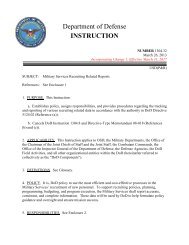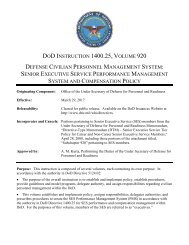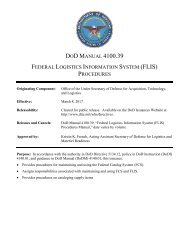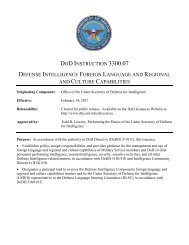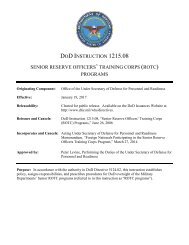520045m
520045m
520045m
You also want an ePaper? Increase the reach of your titles
YUMPU automatically turns print PDFs into web optimized ePapers that Google loves.
1. INTRODUCTION<br />
ENCLOSURE 2<br />
PROCEDURES<br />
8<br />
DoDM 5200.45, April 2, 2013<br />
a. Classification management procedures call for the timely issuance of comprehensive<br />
guidance regarding classification of information concerning any system, plan, program, project,<br />
or mission under the jurisdiction of the OCA, the unauthorized disclosure of which reasonably<br />
could be expected to cause damage to national security. Precise classification guidance is<br />
prerequisite to effective and efficient information security and assures that security resources are<br />
expended to protect only that which truly warrants protection in the interests of national security.<br />
Reference (d) and its implementing guidance, Reference (e), provide general requirements and<br />
standards concerning the issuance of security classification guides while Reference (f) provides<br />
DoD guidance on development, promulgation, distribution, maintenance, and cancellation of<br />
security classification guides.<br />
b. Information is classified, in accordance with guidance in References (d), (e), and (f), to<br />
provide an appropriate level of protection. Therefore, it is essential that a classification guide<br />
identify the specific items of information and the levels of protection required, as well as the<br />
time periods for which protection must be provided.<br />
c. A classification guide will be issued as early as practical in the life cycle of the classified<br />
system, plan, program, project, or mission. The requirements of Reference (f) regarding<br />
classification, declassification, downgrading, marking, and security classification guides should<br />
be reviewed and understood in preparation for writing a security classification guide.<br />
d. DoD information that does not, individually or in compilation, require classification, must<br />
still be reviewed in accordance with DoDD 5230.09 (Reference (i)), prior to any release to the<br />
public. In addition, such information must also be reviewed for compliance with the provisions<br />
of DoDI 8550.01 (Reference (j)), prior to its placement on any publicly accessible Internet site.<br />
Information that does not require classification may nevertheless be exempt from release to the<br />
public or have other restrictions applied when released to other U.S. Government agencies.<br />
e. RD and FRD are unique categories of classified information defined by section 2014 of<br />
title 42, United States Code (U.S.C.) (also known and hereinafter referred to as “The Atomic<br />
Energy Act of 1954, as amended” (Reference (k))) and for which program guidance is provided<br />
in Reference (g). Guides containing RD or FRD topics must be coordinated with DOE, through<br />
the DASD(NM); see part 1045.37(c) of Reference (g) and DoDI 5210.02 (Reference (l)) for<br />
further guidance. Note also that RD and FRD are never automatically declassified and such<br />
information must not include declassification instructions (however, see Reference (f) for further<br />
guidance when RD or FRD and national security information (NSI) are co-mingled).<br />
f. Where applicable, guides should be marked with the appropriate distribution statement<br />
required by DoDI 5230.24 (Reference (m)). Additionally, as needed, guides should provide<br />
ENCLOSURE 2



